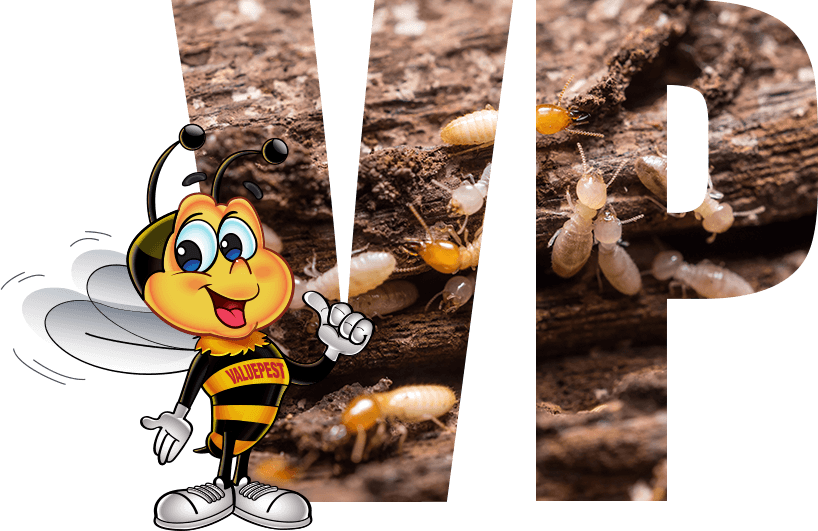
Termite Control
Take Back Your Home
Each year, termites wreak havoc on homes around the country, causing billions of dollars’ worth of damage. They often eat away at the structure of a home for years before being discovered by homeowners. At ValuePest, our ValuePest Ultimate System takes care of your termite control. Our team has the knowledge necessary to provide termite prevention and control, and help real estate agents pass inspections.
Call us at (866) 366-8683 or contact us online to schedule service. We look forward to serving you!
Basic Termite Info
Termites are found in every state except Alaska. They are beneficial to our eco-system because they recycle dead wood. The problem is they cannot tell the difference between a tree limb lying on the ground and the wood members inside the walls of our homes.
Termites are social insects that live in large colonies. There are three caste members: workers, soldiers, and reproductives. Termite colonies are established by winged reproductive termites, which swarm. Swarms usually occurs in the spring – in the morning after a warm rain. A male and female that have swarmed seek out a dark cavity inside which they mate and begin to raise their first group of workers.
After the workers mature, their job is to forage and feed on wood, tend the eggs, and build the mud tunnels and expand the colony presence. Soldiers are produced as the colony matures to repel and defend the colony from invading ants and other predators.

How ValuePest Handles Termite Control
The first step in a termite control program is to remove scrap wood, firewood, and any other wood materials that are in contact with the soil. Also, the subfloor of the entire crawlspace area of the home must be at least 18 inches from the ground to allow for visual inspection and treatment.
Water leaks and other issues causing moisture to be above 20% should be immediately corrected as they are conditions conducive to termite infestation.
A chemical barrier, or treated zone, should be applied around the entire exterior structure to stop termites from entering the home. Other critical areas such as pipe entry into the home and where electrical wires enter the structure should also be inspected and treated when necessary.
A professional control process includes:
- Inspection – A careful inspection of the entire foundation, inside and out, should be performed.
- Identification – Conditions that are conducive to termite infestation should be disclosed to the homeowner. Damage, live termites, cast wings, and mud tunnels should be disclosed. Areas that are inaccessible to inspection should be reported.
- Determination – Once you have identified the issues above, you must determine the proper treatment process.
- Control – Careful and thorough application of residual insecticides are effective in gaining control.
- Communication – The last part of successful termite control is communication. Our technician reports, what was found during our inspection, what we did about it, and what you can expect from our treatment.
Four Costly Misconceptions About Termites
With over 2000 species of termites, we’ve learned that termite control can be very confusing for many homeowners. There are so many misconceptions about these wood devouring insects, that we would like to do our best to help you better understand them and how they can affect your property.
Misconception #1
You can tell very quickly when termites have infested your home because they leave a visible trail of damage.
That is incorrect. The #1 termite problem is that termites are so good at hiding that most homeowners usually don’t see the damage until the infestation is severe. That’s why the annual cost of repairing termite damage to homes in the United States totals several billion dollars each year.
According to the National Pest Management Association, the annual cost of termite damage is actually greater than the cost of damage caused by storms, floods, and fires combined.
Termites make their nest in the soil around and beneath your home in very large, well-organized colonies which can have two or more million members. Formosan termites can chew their way through plywood and beams nine times faster than other species of termites and cause major structural damage to a house in three months. In comparison, it often takes subterranean termites from the three to eight years it to cause significant damage.
Termites can penetrate breaches even in treated soil and some species can build nests above ground. They can tunnel inside the wood, invisibly eating away at the lumber until only a thin shell covers the damage. Without annual inspections by a trained, licensed, certified termite technician, you might not see any visible damage to your home until the termites have already caused extensive structural damage.
These social, wood destroying insects infest your home by building moist, mud tubes that they travel through to get at on all available wooden structures…and termites don’t just stop there. They can also eat paper, books, insulation, and even swimming pool liners and filtration systems.
Formosan termites devour live trees, crops, and plants, and have also been known to eat through non-cellulose material, such as thin sheets of soft metal (lead or copper), asphalt, plaster, creosote, rubber, and plastic, while searching for food and moisture.
Misconception #2
Homes built on slab foundations offer greater protection from termites than homes built with a crawl space beneath the house.
Houses that are built on a concrete slab actually provide easier access for termites to infest the wooden structures because of the shorter distance from the ground to the wood framing. Termites can easily build mud tubes over exposed areas of the foundation and also up through any cracks in the slab.
Termites can enter a home or building through cracks as small as 1/64th of an inch, expansion joints, foam insulation below ground, hollow bricks or concrete blocks, or through spaces around plumbing.
In severe infestations, Formosan termites hollow out the wood, leaving a paper-thin surface that may look blistered or peeled. Paint may appear bubbled and cool to the touch. By the time this evidence is apparent, however, the structural damage to a home may be extensive.
A thorough inspection by a termite control specialist is the first and most important step to protecting your home or building. A certified termite inspector is trained to use a combination of experience, tools and technology to detect the exact location of the infestations. When you catch the problem early, damage may be minimal and the solution relatively inexpensive, by designing a plan of treatment to control current activity and prevent any future infestations.
Misconception #3
Termites are only active in the warmer months when they swarm.
Unfortunately, termites are a 24/7 pest, meaning that they gorge themselves 24 hours a day, seven days a week, putting your biggest investment, your home, at risk.
If you see swarmers emerging from the base of a foundation wall, a porch or patio, window sills or door casings, there’s a good chance your house may have an active infestation. Unless you’re a trained technician, it’s easy to confuse winged termites with ants, which often swarm at the same times of year. Termites have straight antennae, uniform waists and equally sized wings. Winged ants, on the other hand, have elbowed antennae, constricted waists and forewings that are longer than the hind wings.
We recommend that, if it’s been five years since your last termite treatment, you call your local ValuePest office and schedule your initial service.
Misconception #4
If you do discover that you have an active infestation of termites, it’s easy to treat the problem on your own without hiring a licensed pest control company to do the job for you.
That is untrue. Over-the-counter liquid pesticides, called termiticides, bought at retail stores or over the internet rarely do the job sufficiently. To ensure a proper barrier, termiticides need to be applied carefully by a skilled, licensed professional.
The most important factor in treating your home isn’t which pesticide you use. The success of any treatment ultimately depends on four important factors:
- How the termiticide is applied,
- Where the termiticide is applied,
- The amount of termiticide used, and
- The “strength” or dilution rate of the termiticide.
Professional termite treatment requires a wide range of skills and knowledge. A trained termite technician must be familiar with the way homes are constructed, so he or she can identify the most critical points of infestation. Often, these areas are hidden and/or difficult to access.
In effort to provide a continuous insecticide barrier between the termite nest in the soil and the wood in your home, hundreds of gallons of termiticide, must be injected into the ground alongside the foundation, beneath concrete slabs, within foundation walls, within hollow block walls, under the basement, and under the garage floor slab. To completely saturate the soil, special equipment such as masonry drills, pumps, large-capacity tanks, and soil treatment rods are needed.
Proper spacing of all holes drilled into any slab is also critical. Inside the home, carpet may need to be pulled away from walls before application and other flooring requires special attention to avoid damage.
In addition, any holes drilled into a slab must be sealed after drilling to avoid exposure to chemicals by your family or pets.
Termite treatment is not a “do it yourself” home project. If a proper barrier isn’t applied, termites can construct a “bypass” around treated areas and find new points of entry, causing unseen damage that can potentially cost more in repairs than you would have paid for professional treatment.
If you do discover that you have termites, don’t put off the treatment. Call (866) 366-8683 or contact us online today to schedule termite control service.







